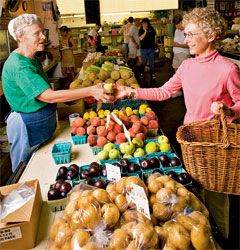I scanned the ingredient list and panicked. “Chicken broth?” I gripped the handle of the shopping cart as I navigated the aisles of the neighborhood grocery store in New York City.
It was 1969. I was a young newlywed, and I didn’t know the first thing about preparing a meal. Frustrated, I crept back to our little apartment in the married-students dorm at the seminary where Merle, my husband, was a grad student. Where do I start?
I was too ashamed to pick up the phone and call my mother. She was a great cook. But then, where Merle and I grew up in the lush green farmland of Lancaster County, Pennsylvania, it seemed like all of the women in Mennonite families like ours were great cooks.
They made hearty food—pork roasted with lots of apples, savory chicken and pot pie, pies bursting with fruit—the kinds of meals that could satisfy a family after a long day laboring in the fields.
I earned pocket money at a stand at Lancaster’s old Central Market, where farmers came to sell their crops and their wives offered apple dumplings and whoopie pies.
Sure, I loved food. But cooking? Ma tried to teach me. I was more interested in reading. I figured I’d tackle the cooking someday. How hard could it be?
That day in 1969 I called my sister-in-law, who patiently walked me through the process of making chicken stock from scratch. “Yes, Phyllis,” I still remember her saying, “first, you get a chicken.”
It wasn’t easy—but it was a breakthrough. I was ready to tackle more recipes in the Betty Crocker cookbook I’d received as a wedding gift—and some of Ma’s dishes too. All through the first year of our marriage Merle was a patient audience. “Almost as good as Mother’s!” he said of my first meatloaf.
One day, I was in our dorm kitchen setting out all the ingredients to fix a little dinner. I’d already made the chicken broth (no sweat this time), shucked the corn, chopped the onions and celery. Yep. I was actually getting good at this cooking stuff. Suddenly, a group gathered around me.
“Looks great, Phyllis,” one of them said. “What are you making?”
“Chicken-corn soup,” I said. “A Pennsylvania Dutch staple.” Before you knew it, I was leading an impromptu cooking class. Me! In that dorm kitchen, the five of us cooked and laughed and tasted together that night. I think what made me qualified to help out novice cooks—I was one of them!
Soon, I felt confident enough to have Merle’s professors over for dinner. I served simple meals—but aren’t those usually the best?
Merle and I moved back to Lancaster County after grad school. We loved New York, but our roots in Pennsylvania were strong. We started a family and opened a cultural heritage interpretation center, where people could learn about the Amish and Mennonites.
Well, visitors had so many questions that we started publishing books. One of our first publications was a cookbook, full of recipes for traditional dishes. Considering my humble beginnings in the kitchen, I’d never imagined I’d ever write cookbooks!
The cookbooks I’m best known for—the Fix-It And Forget-It series—aren’t regional. I get recipes from cooks all over the country. But the food has a lot in common with the food I grew up with. It’s real. It’s uncomplicated. It’s satisfying—and passed on from one cook to another.
Recently I picked up the phone. It was Ma. “Phyllis, can you help me? I need a recipe for the fellowship dinner at church on Sunday.” The Lord had taken me full circle. Nothing we cooks like more than helping one another—including our own mothers!
Try Phyllis’s Oatmeal Dinner Rolls!





